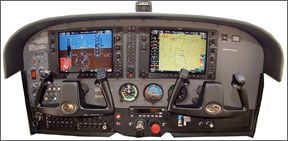It was the best of times, it was the worst of times. Were not talking about Dickens 19th century London, but last week in the used aircraft market. Its the best of times if youre looking for a late-model used aircraft of any kind, the worst if youre trying to sell anything for top dollar.
Stated another way, if you made a note to yourself to start shopping for a used model with glass after theyd been on the market for five year, now would be a
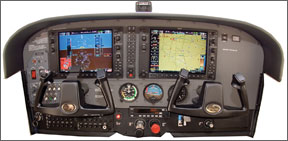
good time. The market is awash with good deals on recent model aircraft and many of them have full glass for under $200,000-the downward pressure on prices is obvious. High inventories and brokers willing to wiggle improve buying prospects.For this article, were focusing on entry level four-place cruisers, specifically the Cirrus SR20, the Cessna 172, the Piper Archer and the Diamond DA40 Star. There are even better deals in the step-up Cirrus SR22, but we’ll focus on that later.
Tipping Point
About five years ago, brokers we occasionally talk to surmised that as Cirrus, Cessna, Columbia (now Cessna), Diamond and others pumped new aircraft into the market, this flood of new airplanes would inevitably put downward price pressure on the used fleet. We seem to have crossed this dividing line, thus the used models that had been appreciating or holding their value, now no longer do. Values of older used aircraft havent yet paralleled the sort of depreciation thats standard for cars, but with fewer buyers, they simply don’t retain value as they once did.
The trend seems to represent an unusually good buying opportunity for owners looking to upgrade to something newer. Some surprisingly recent model aircraft are selling for prices we wouldnt have dreamed of two years ago. For our purposes, “recent” means 1997 forward-thats the year Cessna came back into the market. Two years later Cirrus introduced the SR20, then Diamond rolled out the DA40 Star.
In a market as fragmented as the current one is, we think it makes sense to at least consider setting aside your preference for type of aircraft or even capability and shop strictly on price/value. In other words, the most airplane for the least money.
Weve seen enough extraordinarily good deals to almost wipe out any minor variations in speed, payload and comfort.
Rather than a specific year or model of aircraft, one way of determining relative value in the current market is to consider a median price point-we used $150,000-and compare that across the board against other used aircraft prices. For example, $150,000 might buy a 2000 Cessna 172SP with steam gauges, but it
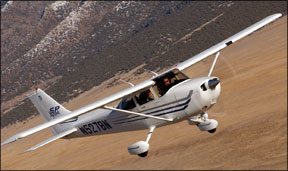
will also buy a 1980 Beechcraft A36. But heres the kicker: For another $15,000, you can probably find a 2005 Skyhawk with Garmin glass. (No kidding.)
And this brings to mind something we’ll call the glass dividing line. At what year model and price point can you now buy a used airplane outfitted with a complete glass panel-either the Avidyne Entegra of Garmin G1000? Here, the numbers are surprising. You can get that new airplane smell and the latest EFIS for a surprisingly small sum. What follows is our market analysis.
Cirrus SR20
Introduced in 1999, the SR20 has been a strong seller for Cirrus, although it was quickly eclipsed by the bigger-ticket SR22. Speed wise, the SR20 is at the top of this list: Its the fastest of the group, cruising typically at 150 knots on 10 to 11 GPH, according to owners. Its typical useful load is about 900 pounds, so with full fuel, there’s room for 560 pounds in the cabin-second only to the DA40.
The Cirrus line has evolved into what has become the TAA or technologically advanced aircraft. But it didnt start out that way. Early models had vacuum-driven
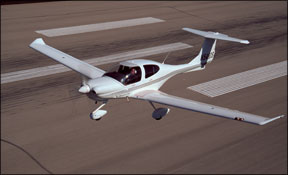
steam gauges and the ARNAV ICDS 2000, an early multi-function display that was mid-1990s start of the art. The early airplanes had three equipment levels, A, B and C. The A airplanes have a Garmin GNS430 and GNC250XL, the ICDS 2000, with an S-TEC System 20 autopilot. B airplanes have a GNS420 in place of the 250 and a System 30 autopilot. C airplanes have dual GNS430s, System 55 autopilots and the Century 1000 HSI. Prices on the early A- and B-equipped versions may be as low as $120,000, but about 70 percent the SR20s had the C package, which seems to sell for about the mid-150s; a good value. In 2002, Cirrus did away with the vacuum system and went to a dual-alternator, all electric mode. In context, thats the better choice, in our view. Cirrus also began offering the Avidyne EX5000 in place of the ICDS 2000, so called 2.0 airplanes.
The big sea change occurred in 2003, when the Avidye Entegra became standard equipment for the SR20. We found more 2004 models listed with the Entegra, for asking prices between $189,000 and just over $200,000. Compared to other offerings, those are good values, but not necessarily the best. If full glass isn’t a must, weve seen 2002 SR20s with the Avidyne EX5000 with asking prices around $170,000. Many of these airplanes have Sandel EHSIs and are thus what might be called near full glass. Because the price Delta to an Entegra system is $30,000, we think the EX5000 airplanes are the better value, if glass isn’t a must-have.
Cessna Skyhawk
Although its a 52-year-old design, Cessna still sells plenty of Skyhawks. In 1997, when it reintroduced the line, the new 172 was designated the R model and shortly
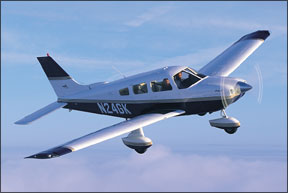
thereafter, the SP or S version came along. The S has a 180-HP upgrade and a different prop. Its max useful load is 837 pounds, compared to the 758 pounds for the R model and we think its the better buy on the used market.
With full fuel, the SP can carry a little less than 500 pounds in the cabin-less than the SR20 by not quite a full person. The SP maxes at about 124 knots, but owners typically fly them a little slower. Cessna lagged Cirrus by a couple of years in switching to glass. While Cirrus was electrifying the market with glass in 2002, Cessna SPs were shipping with dual Bendix/King KX155s and KLN89 or 94 GPS, with KAP140 autopilots. These are certainly competent avionics, but not very sexy. If cutting-edge avionics isn’t a priority, 1999 SPs are retailing at about $100,000 or so. The panels are roomy enough for upgrades, but its not practical to take them to full glass.
Garmin avionics were an option in the Cessnas-including the GNS430 and 530-and some used models have these or have been upgraded. Early 2000s SPs with upgrades retail in the $120,000 to $140,000 range.
Cessna didnt get around to a glass panel for Skyhawks until 2005, but now all new Cessnas have Garmins G1000. And heres where things get interesting. Flightschools bought many of the G1000 SPs and are now turning them over. We found a couple selling for under $170,000, a screaming good deal that will be probably improve as 2009 progresses. These airframes have more hours than an individually owned SP might, but G1000 glass for anything south of $200,000 is a good value, in our view. (But only if cruise speed isn’t a priority.)
Diamond Star
Diamonds DA40 Star has been a steady seller for the company as a step-up from the DA20 series. With its center stick, light control forces and low wing loading, the airplane is exceptionally easy to fly. It also has whats arguably the best safety
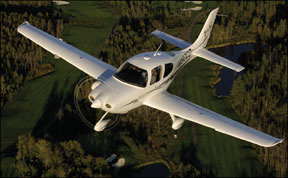
record in general aviation. With a 180-HP Lycoming IO-360, the Star has excellent cruising speed, about 140 knots for the early models and closer to 150 for newer versions. Its payload capability is similar to the Cirrus and Cessna-850 pounds or so with 600 pounds in the cabin with tanks full.
The airplane has some quirks. Because of the bubble canopy, stepping down into the cockpit from the wing is awkward and passengers enter through their own rear hatch. This seems odd at first, but is actually an advantage. The canopy provides superb visibility, but it makes for a warm ride during the summer.
The Star first appeared in 2000, with a Garmin package including a pair of GNS430s and a KAP140 autopilot. Because of its small size, the Star isn’t a good candidate as an avionics boutique. There’s room for the basics, but little else. In 2004, the Star got the Garmin G1000 and in 2006, it added the GFC700 autopilot.
Whats good about Diamonds DA40 Star is also bad about them. These airplanes seem to hold value far better than either Cessna or Cirrus models do. Were not sure why, but our theory is that its a combination of unique appeal and relatively lower sales numbers. Cessna and Cirrus have, at times, pushed the limits of the markets ability to absorb new airplanes and when the market softens, used inventory backs up, tanking prices.
Blasting this theory to bit, unfortunately, is that we found plenty of DA40s for sale-more than 50, including a 2005 G1000-equipped version for $190,000. That strikes us as comparable to the Entegra-equipped SR20 at a similar price. And speaking of Entegras, Diamond offered a few of those in 2003 before switching to the G1000.
There are more SR20s than DA40s to choose from, thus there are more dickering opportunities in the Cirrus market. Still, we found one ad that screamed: “All Glass, At This Price!” It was an Entegra-equipped 2003 model with 1100 hours for $169,000 asking. The best deals in DA40s are on the first two model years 2000 and 2001, which retail in the $150,000 to $160,000 range, if you can find them. We didnt see many, although we found one 2001 Star with 3500 hours for $119,000.
Piper Archer
In this crowd-at least against the Cirrus and Diamond models-the venerable Archer seems dowdy and dated. But the recent models have been updated, with
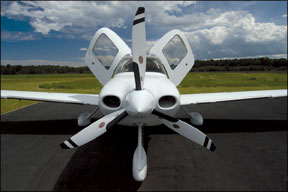
spiffy new interiors, a metal panel and the Entegra EFIS. Pipers production of Archers is but a fraction of what Cirrus, Cessna and Diamond sell. For instance, in 2007, Piper sold 16 Archers to Cessnas 373 Skyhawks, Diamonds 232 Stars and Cirrus 112 SR20s.
No surprise that the Archers performance is similar to its competition. It cruises at about 120 knots on 10 GPH-standard fare for a Lycoming O-360. Payload varies by year. The later models have a 2550-pound gross weight, but because empty weights are higher, payload might not be. Figure about 850 pounds of useful, so full tanks allow 560 pounds in the cabin. Sounds like a lot, but the Archer only tankers 48 gallons of fuel, so range isn’t stellar. We found wide variation between Bluebook retail prices and Controller or Trade-A-Plane asking prices. Bluebook, for instance, lists average retail on a 2001 Archer as $115,000 and Vref had it at about $110,000. Further, Vref had a well-equipped 2003 Archer at $127,000, which is close to Bluebooks estimate. But for a 2000 Archer, we found a Controller listing for $169,000 and a Trade-A-Plane ad for $154,000. Whats going on here? Probably, the Archer is a victim of its low volume-there may not be enough sales to reliably track price trends. If those low numbers are real, however, the Archer would be near the top of the value list.
Piper began offering Entegra glass in 2004, driven by a pair of Garmin GNS430s. Most owners tarted these airplanes up with all kinds of additional goodies, including traffic, datalink and sferics gear, so what used ones are out there are we’ll equipped. Valuations in these airplanes appear to be in $225,000 to $240,000 range. But, by dint of Pipers low production numbers, there arent many used ones on the market, thus judging real value is iffy.
Decisions, Decisions
So wheres the best value here? It depends on where your performance wishes lie and whether having an affordable glass cockpit is a driver for the purchase
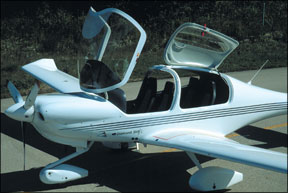
decision. Our sense is that more owners are drifting toward airplanes that are we’ll equipped for short trips, not schedule-sensitive business outings.
If raw speed is your wont, the Cirrus SR20 is the best pick in this lot. Even the early ones are good for 150 knots on 10 GPH. Inventory on these airplanes is substantial and weve seen asking prices as low as $135,000 for a vacuum steam-gauge airplane.
We wouldnt buy an ICDS-equipped SR20 without planning to upgrade it to the Avidyne EX5000. Some already have been upgraded. Its not that the ICDS is so terrible, its just that the market is chock full of much better MFDs and there’s just no percentage in slumming it.
If glass is more important than speed, the Cessna 172SP flightschool castoffs with Garmins G1000 are hands down the best value. There are so many SPs to pick from-not all of them flightschool airplanes-that prices are as low as $170,000 for full-glass airplanes that sell new for nearly $300,000. A loaded new Skyhawk may retail for even higher than that.
At the $170,000 price point, a used Cirrus will more likely be a late steam-gauge model with an EX5000. Entegra glass versions seem to command $20,000 more and will likely be a year older. A word of warning about glass: Upkeep isn’t free. When this equipment is off warranty, its your dime and these systems are far from maintenance free.
Value wise, the Diamond Star and Archer bring up the rear in this group. Its not because they arent great airplanes, but because the market isn’t so flooded with them that inventory has peaked. When fewer have been made, there are fewer to pick from and less equipment variation. Whether that also stunts demand is debatable, but were not seeing fire sales on DA40s and Archers. If glass isn’t a must, the early Diamond Stars-2000 and 2001-are good buys in the $150,000 to $160,000 range. Production appears low for these model years, so there arent as many to choose from as with the Cirrus and Cessna. We saw one 2001 model with a $119,000 asking price and a 2003 Star for $155,000. (The later model has the larger, improved baggage area, a plus.)
Looking forward, we have no idea what 2009 price trends will be. With the manufacturers slowing or halting production, demand may catch up with supply, hardening prices somewhat. But the very best value aircraft occupy a niche of their own and may not decline much in price, if at all.

